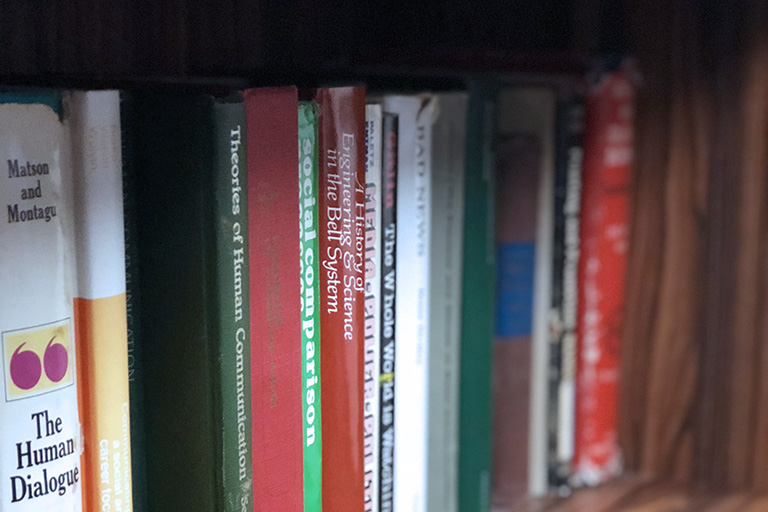Anderson, J., Bresnahan, M.J., & DeAngelis, B.N. (2014). The Impact of Personal Metaphors and Memorable Interpersonal Communication on Body Satisfaction. Qualitative health research, 10497323145296
Anderson, J., Bresnahan, M., & Musatics, C. (2014). Combating Weight-Based Cyberbullying on Facebook with the Dissenter Effect. Cyberpsychology, Behavior, and Social Networking, 17(5), 281-286.
Bente, G., Dratsch, T., Kaspar, K., Häßler, T., Bungard, O., & Al-Issa, A. (2014). Cultures of trust: effects of avatar faces and reputation scores on German and Arab players in an online trust game. PLoS ONE, 9(6). Doi:10.1371/journal.pone.0098297
Bente, G., Dratsch, T., Rehbach, S., Reyl, M., & Lushaj, B. (2014). Do you trust my avatar? Effects of photo-realistic seller avatars and reputation scores on trust in online transactions. HCI in Business - Lecture Notes in Computer Science (Vol. 8527, pp. 461-470). Doi 10.1007/978-3-319-07293-7_45
Bente, G., Dratsch, T., Rieger, D., & Al-Issa, A. (2014). Emotional contagion with artificial others- Effects of culture, physical appearance and nonverbal behavior on the perception of positive/negative affect in avatars. Social Computing and Social Media - Lecture Notes in Computer Science (Vol. 8531, pp. 411–420). Doi:10.1007/978-3-319-07632-4-39
Bergan, D.E., & Cole, R.T. (2014). Call Your Legislator: A Field Experimental Study of the Impact of a Constituency Mobilization Campaign on Legislative Voting. Political Behavior, 37(1), 27-42. Doi:10.1007/s11109-014-9277-1
Bresnahan, M.J., & Zhuang, J. (2014). Special Guest Editor Special Issue on Health Communication in China. Lead essay in this issue entitled The Urgency and Necessity for Health Communication Research in China. Chinese Journal of Communication, 7, 1-8.
Cobbina, J.E., Morash, M., Kashy, D., & Smith, S.W. (2014). Coping strategies to avoid victimization among female probationers and parolees. Race and Justice, 4, 358-380. Doi: 10.1177/2153368714540536
Cobbina, J.E., Morash, M., Kashy, D, & Smith, S.W. (2014). “Race, Neighborhood Danger, and Coping Strategies among Female Probationers and Parolees.” Race and Justice, 4, 358-380. Doi: 10.1177/2153368714540536.
Donohue, W.A., Liang, Y., & Druckman, D. (2014). Walidating LIWC Dictionaries: The Oslo I Accords. Journal of Language and Social Psychology, 33, 282-301, Doi /10.1177/0261927X13512115.
Donohue, W.A., Pugh, F., & Sabrie, S. (2014). Somali piracy negotiations: Resolving the paradoxes of extortionate transactions. Negotiation and Conflict Management Research, 7, 173-187.
Eden, A., Oliver, M.B., Tamborini, R., Woolley, J. & Limperos, M.A. (2014). Perceptions of moral violations and personality traits among heroes and villains. Mass Communication and Society. Doi:10.1080/15205436.2014.923462.
Eden, A., Tamborini, R., Grizzard, M., Lewis, R.J., Weber, R., & Prabhu, S. (2014). Repeated exposure to narrative entertainment and the salience of moral intuitions. Journal of Communication. Doi: 10.1111/jcom.12098
Grizzard, M., Tamborini, R., Lewis, R.J., Wang, L. & Prabhu S. (2014). Being bad in a video game can make us more morally sensitive. Cyberpsychology, Behavior, and Social Networking. Doi:10.1089/cyber.2013.0658.
Grizzard, M., Tamborini, R., Sherry, J.L., Weber, R., Prabhu, S., Hahn, L., & Idzik, P. (2014). The thrill is gone, but you might not know: Habituation and generalization of biophysiological and self-reported arousal responses to video games. Communication Monographs, 1-24. Doi:10.1080/03637751.2014.971418
Hannawa, A.F., Kreps, G., Paek, H.J., Schultz, P.J., Smith, S.W., & Street, R.L., Jr. (2014). Emerging issues and future directions of the field of health communication. Health Communication, 29, 1-7, Doi: 10.1080/10410236.2013.814959
Hitt, R., Gidley, R., Smith, S.W., & Liang, Y. (2014). Traditional vs. social networking routes for organ donation registrations in a competition-based campaign. Journal of Communication in Healthcare, 7, 197-207.
Holmstrom, A.J., Clare, D.D., & Russell, J.C. (2014). Problem- and emotion-focused content in the job search: Two tests of the Cognitive-Emotional Theory of Esteem Support Messages. Human Communication Research, 40, 161-187. Doi: 10.1111/hcre.12025.
Johansson, C., Miller, V.D., & Hamrin, S. (2014). Conceptualizing communicative leadership – A framework for analyzing and developing leaders’ communication competence. Corporate Communications, 19(2), 147-165.
Lapinski, M., Anderson, J., Cruz, S., & LaPine, P. (2014). Social networks and the communication of norms about prenatal care in rural Mexico. Journal of Health Communication, 20, 1-9.
Lewis, R.J., Tamborini, R., & Weber, R. (2014). Testing a dual-process model of media enjoyment and appreciation. Journal of Communication. Doi: 10.1111/jcom.12101
Mollaogul-Korkmaz, S., Miller, V.D., & Sun, W. (2014). Communication among tiers of inter-organizational teams as a key dimension to effective innovation implementation. Engineering Project Organization Journal, 4(1), 17-30.
Nazione, S., Pace, K., Shugart, A., & Smith, S.W. (2014). Encouraging Active Stress Management among Graduate Students: Formative Research for a Persuasion through the Stages Approach. Global Journal of Medical Research, 14, 11-20.
Risner, G., & Bergan, D.E. (2014). Say It With Candy: The Power of Framing Tax Increases as Items. Journal of Political Marketing, 15(1), 22-44. Doi:10.1080/15377857.2014.959685
Robinson, M., Tansil, K., Elder, R., Soler, R., Labre, M., Mercer, S., Eroglu, D., Baur, C., Lyon-Daniel, K., Fridinger, F., Sokler, L., Miller, T., Dearing, J.W., Evans, W.D., Snyder, L.B., Kasisomayajula Viswanath, K., Glik, D., Beistle, D., Chervin, D., Bernhardt, J., Johnson, L., Salmon, C.T., Green, L.W., Rimer, B.K. (2014). “Health Communication Campaigns That Include Mass Media and Health-Related Product Distribution: A Community Guide Systematic Review.” American Journal of Preventive Medicine. 4;47(3): 360-371.
Russell, J., & Boster, F.J. (2014). Measuring the locus of causality as a means of generating explanations for the legitimization of paltry 12 favors effect. Canadian Social Science, 5, 9-14. DOI: 10.3968/4761
Shulman, H.C., & Boster, F.J. (2014). Effect of test-taking venue and response format on political knowledge tests. Communication Methods and Measures, 8, 177-189.
Silk, K.J., Hurley, A., Pace, K., Maloney, E.K., & Lapinski, M. (2014). A diffusion of innovations approach to understand stakeholder perceptions of renewable energy initiatives. Science Communication, 36, 646-669. Doi:10.1177/1075547014549891
Triezenberg, H.A., Gore, M. L., Lapinski, M.K. & Riley, S. J. (2014). The role of persuasive communication in achieving wildlife health goals. Manuscript in press at Wildlife Society Bulletin, DOI: 10.1002/wsb.462
Triezenberg, H.A., Gore, M.L., Riley, S.J., & Lapinski, M.K. (2014). Perceived risks from disease and management policies: An expansion and testing of a zoonotic disease risk perception model. Human Dimensions of Wildlife, 19(2) 123–138.
Westerman, D., Spence, P.R., Van Der Heide, B. (2014). Social Media as an Information Source: Recency of Updates and Credibility of Information. Journal of Computer-Mediated Communication. 19, 171-183.
